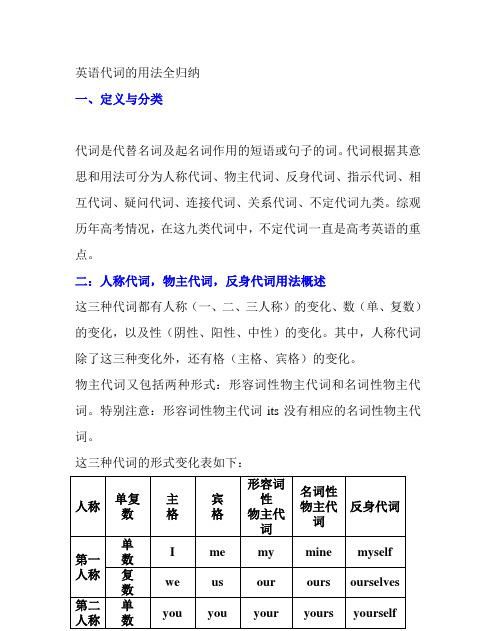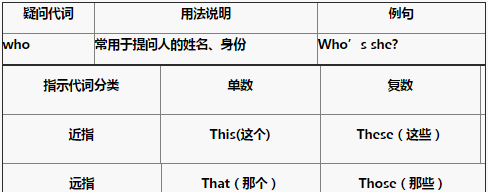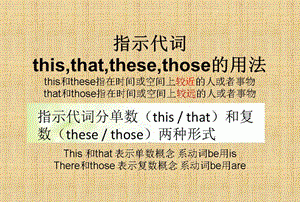本文目录
初一英语上册知识点总结
初一英语是 英语学习 的基础阶段,掌握初一的英语知识有利于打下良好的知识基础。下面是我为大家整理的关于初一英语必备的知识点归纳,希望对您有所帮助。欢迎大家阅读参考学习!
初一英语知识点归纳
1. Morning 指从早晨到中午12点以前的这段时间。
Evening 指晚上,通常为黄昏到入睡之间,即晚上6点到12点。
Night 指夜里,通常为夜晚或夜里就寝前的一小段时间,即9点以后。
Good morning! 早上好! Good afternoon! 下午好! Good night! 晚上好
2. How are you? 你好吗?
用于熟人之间的 问候语 ,只是一种礼貌的问候方式,用来询问对方的身体状况。回答用‖I’m fine , thanks.‖ How do you do ? 你好吗?
用于第一次见面的两个人,互相问候时应用How do you do ?回答也用How do you do ?
----How do you do ? ----How do you do ?
3. Thank you! 谢谢你!当别人帮助,关心,问候,祝福我们时,应用Thank you ;当得到对方的称赞,夸奖时也用Thank you.
4.This 是指示代词,可单独使用,指离说话人较近的人或物。
That 指离说话人较远的人或物。
5.a/an 为不定冠词 常见用法: ①表示数量―一‖ a pen 一支钢笔 an apple 一个苹果 注:an 用于元音前,元音包括5个:(A E I O U ) ②泛指某人或某物,不是具体说明 A girl is over there. 一个女孩在那边。 ③在叙述时第一次提到某人或某物 She is a teacher. 她是一个老师。
6.Spell it , please. 请拼写它。 请求对方拼写某一词语的句型还有: ① How do you spell it? 你怎么拼写它? 回答可以直接写出:P-E-N. ② Can you spell it, please? 由can引导的一般疑问句,应先用Yes或 No进行肯定或否定回答后,才能拼写。 Can you spell it please? Yes, I can. P-E-N. 请问你能拼写它吗? 是的,我能
初一英语知识要点
我(I)用am;你(you)用are;is跟着他(he)、她(she)和它(it)。
单数名词用is,复数名词全用are。否定句中,直接在be动词后加not。疑问句中,be动词往前提,句末用问号。还有一条要注意,be动词在句首时要大写。
(1)this和that是指示代词,it是人称代词。
(2)距离说话人近的人或物用this, 距离说话人远的人或物用that。
如:This is a flower. 这是一朵花。(近处)
That is a tree. 那是一棵树。(远处)
(3)放在一起的两样东西,先说this,后说that。
如:This is a pen. That is a pencil. (这是一支钢笔。那是一支铅笔)
(4)向别人介绍某人时说This is„, 不说That is„。
如:This is Helen. Helen, this is Tom.( 这是海伦。海伦,这是汤姆)
(5)This is 不能缩写, 而That is可以缩写。
如:This is a bike. That is a car. (这是一辆自行车。那是一辆轿车)
(6)打电话时,介绍自己用this,询问对方用that。
如: —Hello! Is that Miss Green? (喂,是格林小姐吗?)
—Yes, this is. Who’s that? (是的,我是,你是谁?)
注意:虽然汉语中使用“我”和“你”,但英语中打电话时绝不可以说:I am ___或者
Who are you? 或者Are you ___之类的话。
如:①—Is this a notebook? (这是 笔记本 吗?)
—Yes, it is. (是的,它是。)
②—What’s that? (那是什么?)
—It’s a kite. (是一只风筝。)
初一英语知识点
(1)There be句型主要用以表达“某处(某时)有某人(某物)。”
其基本结构为“There be+某物(某人)+某地(某时)”。其中there是引导词,没有词义;主语是be后面的名词, be是谓语动词,在一般现在时中be只用is和are两种形式。如:There is a book on the desk.
有时为了强调地点,也可把介词 短语 放在句首。如:On the desk there is a book.
(2)There be句型中的be动词如何确定呢?请先看看下面这首歌诀:
“Be动词,有三个,am,is还有are。“There be”真特别,不留am只留俩,那就是is还有are。要用is还是are,须看其后的名词是单数还是复数。若是单数或不可数名词用is,否则就用are。”
如:①There is a tree behind the house.
②There is some water(水)in the bottle(瓶子).
③There are some pears in the bo_.
(3)注意:如果“be”后的主语是由and连接的两个或两个以上的名词,那么be的形式要遵循“远亲不如近邻”的原则。也就是说,“be”的形式是由与它最近的那个名词来确定的。若那个名词是单数或不可数名词要用is,是复数就用are。
如:①There is a book and some pens on the floor.
②There are some pens and a book on the floor.
相关 文章 :
1. 初一英语语法知识点总结归纳
2. 初一英语知识点总结
3. 初一英语知识点总结
4. 初一英语知识点总结
5. 初一英语语法知识点总结复习

初中英语代词知识点归纳总结 初中英语代词知识点归纳总结有哪些
1、代词的分类:人称代词、物主代词、反身代词、指示代词、关系代词、疑问代词、连接代词、不定代词和相互代词等。
2、人称代词:人称代词代替人或事物的名称,分为主格和宾格两种形式。
3、物主代词:说明事物所属关系的代词,分为形容词性和名词性两种。
4、反身代词:表示谓语的动作与主语有关或者宾语补足语的动作与宾语有关。
5、指示代词:指示说明近处或者远处、上文或者下文、以前或者现在的人或事物。
6、关系代词:用来引导定语从句的代词叫关系代词。
7、连接代词:用来引导宾语从句、主语从句或表语从句的连接词称连接代词。
8、疑问代词:用来提出问题的代词称为疑问代词。
9、不定代词:代替或修饰不特指的人或事物的代词叫不定代词。
10、相互代词:表示相互关系的词叫相互代词。

六年级小升初英语知识点总结
1、动词be(is,am,are)的用法
我(I)用am, 你(you)用are,is跟着他(he),她(she),它(it)。单数名词用is,复数名词全用are。变否定,更容易,be后not加上去。变疑问,往前提,句末问号莫丢弃。还有一条须注意,句首大写莫忘记。
2.this,that和it用法
(1)this和that是指示代词,it是人称代词。
(2)距离说话人近的人或物用this, 距离说话人远的人或物用that。如: This is a flower. 这是一朵花。(近处)
That is a tree. 那是一棵树。(远处)
(3)放在一起的两样东西,先说this, 后说that。如:
This is a pen. That is a pencil. 这是一支钢笔。那是一支铅笔。
(4)向别人介绍某人时说This is…, 不说That is…。如:
This is Helen. Helen, this is Tom. 这是海伦,海伦,这是汤姆。
(5)This is 不能缩写, 而That is可以缩写。如:
This is a bike. That’s a car. 这是一辆自行车。那是一辆轿车。
(6)打电话时,介绍自己用this, 询问对方用that。如:
-Hello! Is that Miss Green? 喂,是格林小姐吗?
-Yes, this is. Who’s that? 是的,我是,你是谁?
注意:虽然汉语中使用“我”和“你”,但英语中打电话时绝不可以说:I am…, Are you…?/Who are you?
(7)在回答this或that作主语的疑问句时, 要用it代替this或that。如:
①-Is this a notebook? 这是笔记本吗?
-Yes, it is. 是的,它是。
②-What’s that? 那是什么?
-It’s a kite. 是只风筝。
3.these和those用法
this, that, these和those是指示代词,these是this的复数形式,指时间,距离较近的或下面要提到的.人或事;those是that的复数形式,指时间、距离较远或前面已经提到过的人或事物。
①This is my bed. That is Lily’s bed. 这是我的床。那是莉莉的床。
②These pictures are good. 那些画很好。
③ Are those apple trees? 那些是苹果树吗?
在回答主语是these或those的疑问句时,通常用they代替these或those以避免重复。如:
④Are these/those your apples? 这些(那些)是你的苹果吗?
Yes, they are. 是的,他们是。

关系代词的分类及用法
(一)代词的类别
相互代词 each other,one another
指示代词 this,that,these,those
不定代词(不指明特定的人或事物的代词)each,every,both,all,either,neither,none,no,one,(a)few,(a)little,some,any,many,much,other,another
复合不定代词 everybody,somebody,anybody,nobody,everyone,someone,anyone,no one,every-thing,something,anything,nothing
疑问代词 what,who,whom,which,whose
直接代词 疑问代词都可作连接代词,引导宾语从句.表语从句等.
关系代词 who,whom,whose,that,which用引导定语从句.
(二)代词的用法
1.人称代词、物主代词、反身代词、相互代词和指示代词的用法
(1)人称代词有主格和宾格之分,主格用来作主语,宾格用来作动词或介词的宾语等.
eg. She gave me a red apple.她给了我一个红苹果: (She作主语,me作动词宾语)
Kath is near him.凯西靠近他.(介词near的宾语)
2.物主代词有形容词性物主代词和名词性物主代词之分.
①形容词性物主代词位于名词前:their school,his backpack
②名词性物主代词相当干一个名词,在句中可作主语、宾语等,后面不能再接名词.
egIt isn’t my pen.→Mine(=my pen) is missing.(作主语)
I left my pen at home. You can use hers(=her pen),(作宾语)
③“of+名词性物主代词”属双重所有格的一种形式.
eg.a cat of hers她的一条狗,a friend of yours你的一个朋友
3.反身代词
①反身代词在句中可作同位语,起强调作用,也可作动词或介词的宾语.
eg.A few days later,I myself had to go to Paris.(作同位语)
She bought herself a new bag.(作动词宾语)
He’s not worried about himself.(作介词宾语)
②带有反身代词的常用短语.
teach oneself 自学
help oneself to 随便吃些…吧
say to oneself 自言自语.
learn……by oneself 自学…
enjoy oneself 过得愉快
leave one by oneself 把某人单独留下
hurt oneself 伤了自己
dress oneself 自己穿衣服
come to oneself 苏醒过来
4.相互代词
①表示相互关系,可用作动词或介词的宾语,用法区别不大.
eg. For years, the two sisters looked after one another(each other).多年来姐妹俩互相照顾.
We should learn from each other. 我们应当互相学习.
②可以用格表示所有关系:each other’s, one another’s互相的,彼此的
eg.They are looking at each other’s pictures.他们相互看对方的照片.
5.指示代词
①指示代词有单复数之分,既可指物,也可用于介绍人.
eg. This is an apple tree,and that is an orange tree.这是一棵苹果树,那是一棵桔子树.
These are my friends,and that is my sister.这些是我朋友,那个是我姐姐.
②指示代词可用来指上文中提到的事情:
eg.Steve had a bad cold.This/That was why he didn’t come to school yesterday.
2.不定代词
(1)each,every,both,all,either,neither,no,none的用法
①each“每个/各个”(强调个体),用于两者或两者以上.
eg.Two girls came and l gave an apple to each.来了俩姑娘,我给她们每人一个苹果.
Each of them has a nice ring.她们每人有一枚漂亮的戒指.
②every“每个/各个”(强调全体),用于两者以上.every常作形容词用.
eg.Every day is important to us.每天对我们都很重要.
He has read every book(all the books) On the subject.他阅读了所有有关这个主题的书.
③both表示两者“都”(强调全体).
eg.Her parents are both doctors.她父母都是医生.
Both of them are doctors.他俩都是医生.
They both like potatoes.他俩喜欢吃土豆.
④all“全体/大家/一切”用于三者以上,也可接不可数名词.
eg.That’s all for today.今天到此为止.
All of us are from China.我们都来自中国.
All the food is delicious.所有的食物都很好吃.
⑤either“两者之一”,用于两者(强调个体).
eg.The two coats are cheap,so you can choose either of them.那两件外套不贵,你可以随便挑一件.
⑥neither“两个都不”,用于否定两者.
eg. Neither Of the books is/are so interesting.那两本书没一本好看的.
⑦no(=not any/not a)“没有”可接可数名词单复数,也可接不可数名词.
eg.I have no brothers Or sisters.我没有兄弟姐妹.
A clock has no mouth,but it can talk. 钟表没有嘴,但能说话.
There is no fire without some smoke.有火就有烟.
⑧none“没有一个人/物”用于否定三者或三者以上的可数名词
eg.None Of them has/have been to Japan.他们都没去过日本.
I like none of the books.这些书我全都不喜欢.
⑨neither和none表示完全否定;all,both,each和every(含every的复合词)等与not连用时表示部分否定.
eg.I don’t know all of you.我不完全认识你们.
Not everyone Of us know how to go there.不是我们每个人都知道怎样去那儿
(2)one,ones和no one的用法
one用来代替前面刚提到的一个东西或一个人,以免重复;复数ones用来代替前面提到的一些物或一些人;no one表示否定.
eg.——Would you please pass me the science book?给我递过那本科学方面的书好吗?
一Which one?哪一本?
一The one on my shelf.我书架上的那本.
No one has traveled farther than to the moon.没有人旅行远过月球.
(3)(a)few,(a)little;many,much;some,any的用法
①many(+复数名词),much(+不可数名词)表示“许多/很多”.
eg.Many Of the students come from England.那些学生许多是从英国来的.
Thanks,it’s too much for me.谢谢,我承受不起.
②few(+复数名词),little(+不可数名词)表示“没多/很少”(表否定).
eg,There were few people in the street last night.昨晚街上没什么人.
I am very worried that l have little time to finish the job.我担心,我几乎没有时间完成这份工作了.
③a few(+复数名词),a little(+不可数名词)表示“有一些/有几个”(表肯定).
eg.I call see a few cakes and a little bread inthe fridge.我看到冰箱里有几块蛋糕和一些面包.注意:quite a few表示“相当多”
eg.There are quite a few students over there.那儿有相当多的学生.
④some(+复数名词/不可数名词),any(+复数名词/不可数名词)表示“有一些/有几个”(表肯定).
eg.There are some birds in the tree.树上有些鸟.
There is some water in the bottle.瓶里有些水.
I don’t have any brothers Of sisters.我没有
Is there any tea in the cup?杯子里有茶吗?
⑤some一般用于肯定句,但在表示请求、建议.反问等的疑问句中,多用some.
eg: Would you like some beer?你要不要来点啤酒吗?
Why didn’t you buy some sweets?(You should have bought……)你怎么没买点糖果?
⑥any一般用于疑问句和否定句及条件从句
eg.There isn’t any water left.没有剩下一点水.
If you have any questions, put up your hands.please.如果有问题,请举手.
⑦some+单数名词表示“某一个”,any+单数名词表示“随便哪一个”或“任何一个”.
eg.I’ll catch up with you some day有一天我会赶上你的.
Come any day you like.你哪天来都行.
Tom is taller than any other student in his class.汤姆比他班上其他任何一个学生都高.
④one ,other, others, the others ,another等的用法
1.○ ● one……the other
表示两个人或两件东西中的“一个…另一个”
eg.Mr Smith has two daughters.0ne is a teacher,the other is a nurse.
2.one……another
表示不定数目中的“一个”与“另—个”.
eg. I don’t want this One, please give me another.
3..one ……the others
强调在一定范围中的“一个”与“其余的”.
eg. In Our school One Of the teachers is American,the Others are Chinese
(4)复合不定代词的用法
①复合不定代词作主语时,谓语动词用单数形式.
eg.Someone is knocking at the door.有人在敲门
②修饰复合不定代词的形容词或其它词要放在其后,即定语后置.
eg.There is something important On today’s newspaper.今天的报纸有些重要新闻.
③复合不定代词变否定句时,要否定主语:
eg.Something is wrong.(变为否定句)
Something isn’t wrong.(错误)
Nothing is wrong.(正确)
④Somebody,someone,something一般用于肯定句;anybody,anyone,anything一般用于否定句、疑问句及条件句.
eg.There is something new in the park.公园里有些新的景点.
Do you have anything interesting to tell us?你有什么有趣的事要告诉我们吗?
⑤当somebody,someone等用于疑问句时,表示肯定、请求、建议或反问;anybody,anyone等用在肯定句中表示“任何人”.
eg.Is someone coming this afternoon?今天下午有客人来吗?
Anyone can make mistakes. 任何人都可能犯错误.
3.疑问代词的用法.
(1)who/whom 谁(指人).
①作主语 eg. Who wants to go with him?
②作宾语 eg.Who/Whom are you waiting for?(作介词for的宾语)
eg.Who/Whom do you want to meet?(作动词meet的宾语)
③作表语 eg.Who/Whom are they?
(2)whose谁的
①作定语 eg. Whose pen is this?
②作表语 eg. Whose is this pen?
(3)which哪一个,哪一些
①作定语 eg.Which girl is Kathy?
②作表语 eg. Which is the boy’s ball?
(4)what什么
①作主主语 eg. What’s on the table?
②作宾语 eg. What are you doing?
③作表语 eg. What is he?
④作定语 eg. What class are you in?
4.关系代词的用法
关系代词用来引起定语从句,它一方面代表定语从句所修饰的那个名词或代词,另——方面又在从句中充当一个成分.
eg·This is the man who gave me the book. 这就是给我书的那个人.
The money that/which is on the table is mine. 桌上的钱是我的.
The money that/which my mother gave me is on the table. 我妈妈给我的钱在桌上.
初中英语语法代词知识点总结仅供各位参考和学习,祝大家学习进步!

以上就是关于指示代词知识点的归纳总结 ,初一英语上册知识点总结的全部内容,以及指示代词知识点的归纳总结 的相关内容,希望能够帮到您。

